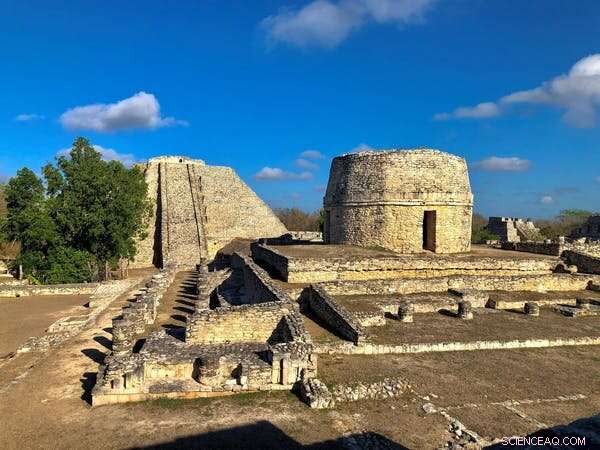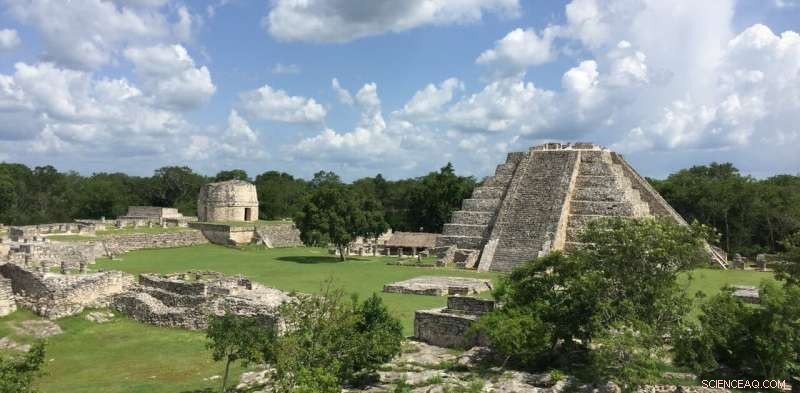
Arkeologer har undersökt platsen för Mayapán sedan 1950-talet. Kredit:Bradley Russell, författare tillhandahållen
Staden Mayapán var den största mayastaden från cirka 1200 till 1450 e.Kr. Det var ett viktigt politiskt, ekonomiskt och religiöst centrum och huvudstaden i en stor stat som kontrollerade stora delar av nordvästra Yucatan i dagens Mexiko.
När spanjorerna anlände i början av 1500-talet blev Mayapán varmt ihågkommen och mayafolket hävdade stolt att de härstammade från sina tidigare medborgare. Men inneboende instabilitet gjorde att den var dömd att misslyckas.
Eller så gick historien. Denna berättelse har påverkat synen på denna viktiga stad och denna period av mayacivilisationen mer allmänt under en tid.
I en ny studie visar mina medarbetare och jag att krigföring, kollaps och övergivande vid Mayapán inte var oundvikliga. Istället förvärrades de av torka.
Spår av en massaker
Experter från ett brett spektrum av områden arbetade tillsammans för att få ihop den här historien. I teamet ingick arkeologer, biologiska antropologer, geologer och paleoklimatologer.
Arkeologer ledda av Carlos Peraza Lope från Instituto Nacional de Antropología e Historia i Mexiko och Marilyn Masson från University at Albany—State University of New York har undersökt ruinerna av Mayapán intensivt sedan 1996 respektive 1999. Intermittent arbete har pågått på platsen sedan 1950-talet.
Forskare har länge misstänkt att Mayapán kollapsade våldsamt, baserat på tidiga koloniala dokument. Dessa dokument beskriver en revolt ledd av den adliga familjen Xiu som resulterade i massakern på den regerande familjen Cocom.
När arkeologer från Carnegie Institute of Washington började undersöka platsen på 1950-talet blev de inte förvånade över att hitta begravda kroppar som inte hade fått den vanliga respektfulla begravningsbehandlingen.

Kredit:Bradley Russell, författare tillhandahållen
Skändning och förstörelse
Jag är bioarkeolog, vilket betyder att mitt jobb var att leta efter bevis på trauman i skeletten som kan ha bidragit till dessa individers död. Dessa bevis skulle stödja idén om en våldsam kollaps av staden.
De flesta begravningar saknade bevis på våld. Vissa uppvisade dock skador som inbäddade pilspetsar, sticksår eller trubbigt våld på skallen.
Tecknen på våld koncentrerades till viktiga sammanhang på platsen och hittades i samband med bevis på vanhelgande och avsiktlig förstörelse. Det verkar som om några av webbplatsens egna elitinvånare hade varit föremål för våld.
Ökande våld
För att ta reda på när denna konflikt inträffade, och hur den relaterade till förändringar i klimatet, krävdes ett stort antal högprecisionsdatum för radiokolväten och paleoklimatdata från Mayapáns närhet.
Dessa analyser utfördes i laboratoriet av Douglas Kennett vid University of California, Santa Barbara, David Hodell vid University of Cambridge och kollegor.
As a result, we now have more radiocarbon dating information for Mayapán than for any other Mayan site.

The temple of Kukulkan, dedicated to the feathered serpent deity, was at the heart of Mayapán’s most sacred precinct. Credit:Susan Milbrath, Author provided
Paleoclimate data, meanwhile, was obtained from a stalagmite recovered from a cave directly beneath the site's principal temple pyramid, which was dedicated to the feathered serpent deity Kukulkan.
These analyses revealed that episodes of violence became more common later in the site's history, corresponding with evidence of drought that began in the late 1300s and continued into the 1400s.
One mass grave in particular, recovered in Mayapán's most sacred precinct at the foot of the temple of Kukulkan, appeared to date to around the time of the city's purported collapse in the mid-1400s. Remarkably, this was confirmed through radiocarbon analyses, corroborating historical accounts of the site's violent overthrow at this time.
Drought and decline
But the story does not end there.
Radiocarbon dating also provided the surprising result that Mayapán's population started falling after approximately 1350 AD. Indeed, the city was already largely abandoned by the time of its famous collapse in the mid 1400s.
It may be that as drought continued through the late 1300s, the residents of Mayapán started voting with their feet.
After Mayapán's fall, the city's former inhabitants returned to their ancestral homelands in different parts of the Yucatan Peninsula. By the time of Spanish contact in the early 1500s, the peninsula was divided into a number of independent provinces, some of which were thriving.
Climate migration
Although from a vastly different time and place, our study contributes to current efforts to combat global climate change.
When environmental conditions were favorable, populations expanded. But when conditions deteriorated, this put pressure on social and political institutions.
Mayapán's people migrated away from the city to cope with the change in climate. While migration may be less of a solution in the face of today's climate change, due to global population levels, climate refugees are expected to rapidly grow in number without significant action by governments and citizenry alike.
Big questions, big collaboration
To address big questions such as this requires a level of multidisciplinary collaboration that is difficult to achieve but essential.
Importantly, local Yucatecan Mayan communities have been integral to this process. Inhabitants of the equally ancient town of Telchaquillo, located just outside Mayapán, have contributed to this work in innumerable ways, including excavation, artifact cleaning, processing and analysis. + Utforska vidare
Den här artikeln är återpublicerad från The Conversation under en Creative Commons-licens. Läs originalartikeln. 